Have you ever wondered what makes riads special? In Morocco, riads are a big deal in the hospitality world. They offer a unique choice compared to regular hotels. A riad is usually a traditional Moroccan home with a lovely garden or courtyard inside. It’s known for its beautiful architecture and peaceful vibe.
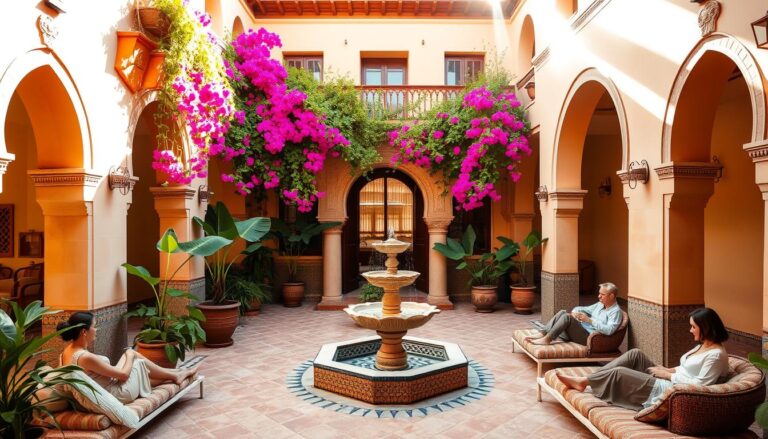
When you travel to Morocco, staying in a riad is a great way to dive into the local culture. Unlike hotels, riads are often run by families. This gives you a personal experience that you’ll always remember.
When you enter the world of Moroccan Riads, you’re surrounded by history and culture. These homes are architectural wonders and keepers of Moroccan heritage.
Riads come from Morocco’s traditional architecture, dating back to when the wealthy lived here. The word “riads” comes from “ryad,” meaning garden. Historically, riads had a central garden or courtyard, showing a peaceful oasis in the busy medinas of Moroccan cities.
In Moroccan society, riads are cultural icons, showing values of hospitality and family. They are cozy and private, with intricate zellij tile work and carved wooden ceilings that show Morocco’s rich craftsmanship.
Travelers love riads for their mix of old charm and modern comfort. Staying in a riad gives you an authentic Moroccan experience. It lets you dive into local culture and history. Riads offer personalized service and a calm atmosphere, making them a top choice for those wanting a deep connection with Morocco.
By choosing a riad, you’re not just picking a place to stay. You’re embracing a part of Moroccan culture and history.
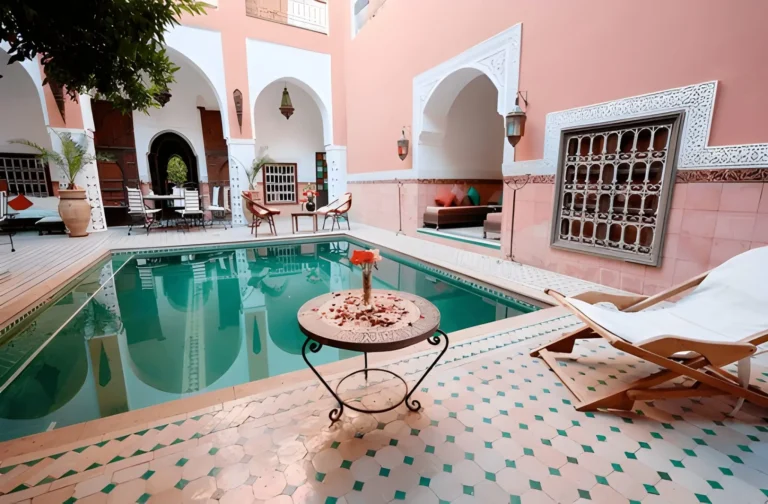
The word ‘riad’ comes from the Arabic ‘ryad,’ meaning garden or paradise. This shows the peaceful and beautiful nature of riads. They are traditional Moroccan houses with a garden or courtyard inside.
Riads have been key in Moroccan architecture for centuries. They are not just homes but also symbols of status and hospitality. The interior courtyard, often with lush gardens and fountains, is a key feature of riad design.
The term ‘riad’ is linked to the idea of a garden or a peaceful place. In Moroccan architecture, it means a house or palace with an interior garden or courtyard. This design makes a calm oasis in the busy medinas of Moroccan cities.
Riads have several important architectural features, including:
| Architectural Element | Description | Significance |
|---|---|---|
| Interior Courtyard | Central open space surrounded by the riad’s rooms | Provides natural light and ventilation |
| Zellij Tile Work | Intricate geometric tile patterns | Adds visual beauty and reflects Moroccan craftsmanship |
| Carved Wood and Plaster | Intricately carved decorative elements | Enhances the aesthetic appeal and historical significance |
The design of a riad is deeply rooted in Islamic architecture and Moroccan culture. The focus on interior spaces shows the importance of privacy and creating calm environments. The use of gardens, fountains, and decorative elements is not just for beauty. It also symbolizes the paradise or garden described in the etymology of ‘riad.’
Exploring riads reveals each one’s unique reflection of Moroccan culture and architecture. Whether you’re staying in a riad or just admiring it, understanding its design philosophy can deepen your appreciation of this traditional Moroccan home.
When you enter a riad, you’re surrounded by traditional Moroccan architecture. This design is deeply rooted in Moroccan culture and history. It creates a unique and serene atmosphere.
The central courtyard is the heart of any riad. It’s a peaceful oasis surrounded by high walls. These walls keep the outside world out.
This open-air space is filled with lush greenery and decorative fountains. It creates a calm ambiance that soothes the soul.
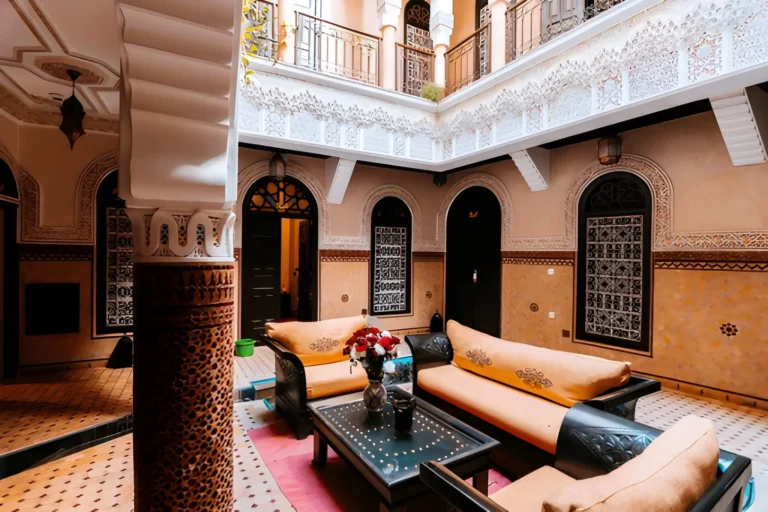
Water features and fountains are key parts of riad design. They add a soothing sound to the atmosphere. The sound of running water cools the air and brings tranquility.
This makes the riad a perfect escape from Morocco’s busy streets.
Heat varies by region, making some places better for summer visits. Knowing this helps plan your trip well.
Riads are famous for their traditional Moroccan craftsmanship. You can see this in the decorative elements throughout. The craftsmanship includes detailed tile work, carved plaster, and beautifully crafted wood ceilings.
Zellige tilework is a standout feature of riad architecture. These small, glazed tiles form stunning geometric designs. They adorn walls, floors, and fountains.
Zellige tilework is not just beautiful. It also shows Morocco’s rich cultural heritage.
Tadelakt is a traditional Moroccan plastering technique. It involves applying layers of lime plaster to create smooth surfaces. This technique is used for walls and decorative elements.
It gives a luxurious finish that is both durable and visually appealing.
Cedar wood ceilings are a hallmark of riad architecture. They add warmth and elegance to the interiors. The cedar wood is often intricately carved.
This creates a sense of depth and visual interest. It complements the other decorative elements in the riad.
The combination of these architectural elements makes a riad more than just a place to stay. It’s a reflection of Morocco’s rich cultural heritage and craftsmanship.
Planning your Moroccan trip means deciding between a riad or a hotel. Each offers a unique experience, suited to different tastes and travel styles.
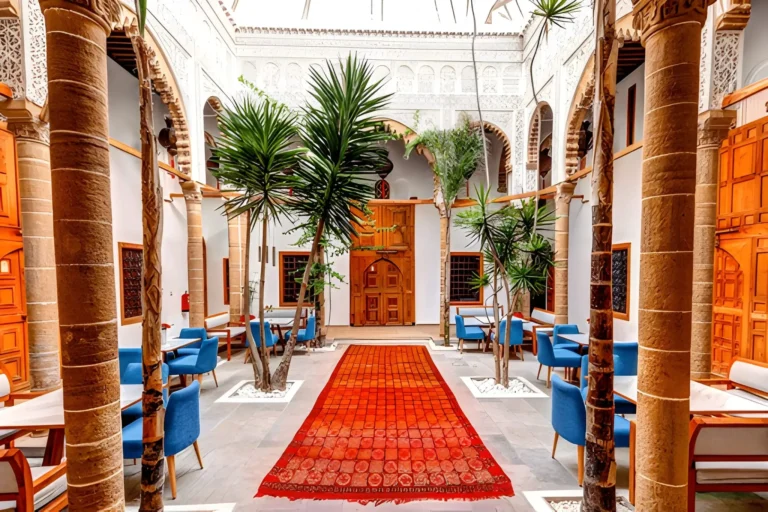
Riads are smaller than hotels, creating a cozy atmosphere. They have fewer than a dozen rooms. This makes guests feel like part of the family.
Hotels, with hundreds of rooms, offer more amenities and services. But riads focus on the charm of a traditional Moroccan home, not just a place to stay.
Riads provide more personalized service. With fewer guests, staff can focus on meeting each guest’s needs. This personal touch is key to the riad experience.
Hotels, being larger, have a more standardized service. They offer a wide range of services but might not have the same personal attention as riads.
Riads give a true look at Moroccan culture and architecture. They’re often in ancient medinas, providing an immersive experience. But they might not have all the modern conveniences.
Hotels, like international chains, have modern amenities like gyms and pools. But they might not have the cultural charm of riads.
Riads and hotels have different prices. Riads, in prime spots, can be pricey. But they often include extras like meals and personalized service, adding value.
Hotels offer various price options, from budget to luxury. They might not offer the cultural immersion of riads. But they provide consistent amenities and service.
Choosing between a riad and a hotel depends on what you value most in Morocco. Whether it’s authenticity, modern conveniences, or personal service, knowing the differences helps you decide.
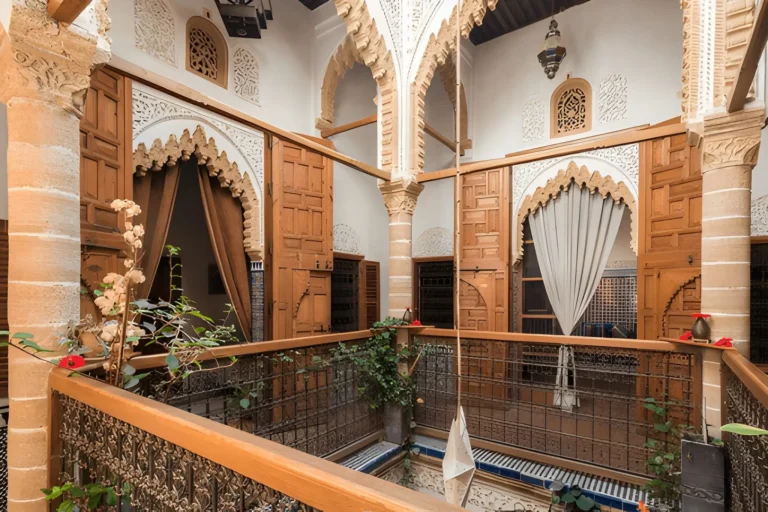
Your riad is more than a place to sleep. It’s a chance to live like a local in Morocco’s lively cities. Knowing what to expect can make your stay unforgettable.
You’ll get a warm welcome when you arrive. The check-in is easy, with your host telling you about the riad’s features. Then, you can explore your room and the riad.
Riad rooms are cozy and peaceful, with Moroccan decor and modern comforts. You’ll find nice bathrooms, comfy beds, and maybe a balcony or courtyard view. Each room is special, showing off the riad’s unique charm.
Many riads have their own restaurants, serving Moroccan and international food. Enjoy breakfast on your balcony or in the courtyard, surrounded by greenery and fountains. Some riads even offer cooking classes, letting you explore Moroccan cuisine.
The rooftop terrace is a highlight, with views of the medina. It’s great for relaxing, meeting other guests, or enjoying the local vibe.
Riads offer Wi-Fi, laundry, and tour bookings to make your stay better. Your host can give you tips and recommendations for the area, making your stay even more fun.
By knowing what to expect, you can enjoy a unique and memorable stay in Morocco.
Choosing the right riad in Morocco is key to a great stay. You need to think about location, read reviews, and pick a style that fits your trip. This ensures your Moroccan adventure is unforgettable.
The riad’s location is very important. It affects how close you are to sights and the feel of your stay. Morocco’s cities and towns offer different riad experiences.
Marrakech riads are lively and close to places like Jardin Majorelle and Jemaa el-Fnaa. They offer a vibrant atmosphere.
Fes riads are quieter, set in the ancient medina. They give you a deep dive into history.
Coastal riads in places like Essaouira are calm and beach-focused. Mountain riads are peaceful and natural.
Reviews from past guests are very helpful. Look for riads with lots of positive comments on cleanliness, hospitality, and amenities.
Riads come in many styles, from traditional to modern. Think about what kind of vibe you want for your stay.
| Riad Style | Characteristics | Ideal For |
|---|---|---|
| Traditional | Intricate tile work, classic furnishings | Cultural immersion, authenticity |
| Modern | Minimalist decor, contemporary amenities | Those seeking a blend of tradition and modern comfort |
| Luxury | High-end amenities, spacious rooms | Travelers looking for a premium experience |
By thinking about these things, you can find a riad that will make your Moroccan trip amazing.
Booking a riad is easy with a few simple steps. This ensures your Moroccan trip is perfect. Knowing how to book a riad helps you make better choices and enjoy your stay more.
Several websites can help you find a riad. Sites like Booking.com, Airbnb, and riad booking sites have many options. It’s important to compare prices and services to find the right one for you. Also, check travel forums and blogs for riad recommendations.
Ask important questions before you book. Find out about the riad’s location and accessibility and what amenities it offers. Also, know the riad’s policies on cancellations and refunds to avoid problems.
Riad prices change with the season. Prices are usually higher during the high season (October to April). Booking early can get you a better rate. Remember to check for any extra costs like taxes or service charges.
Many riads offer airport transfers. This makes arriving easier and lets you learn about local culture. Knowing how to get around the medina is also key. Your riad can help with maps and directions.
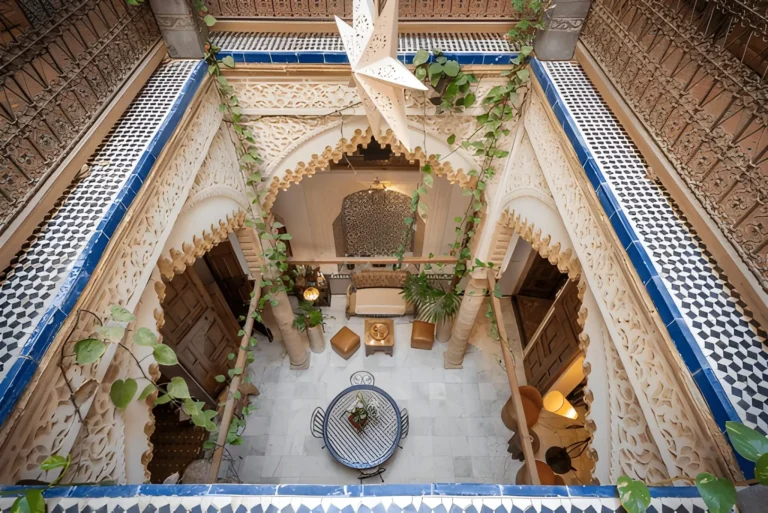
Getting ready for your riad adventure? Keep these tips in mind for a real experience. Staying in a riad is more than just a place to sleep. It’s about diving into Morocco’s rich culture.
Respecting Moroccan customs is key when you’re with your riad hosts and out in the medina. Saying “As-salamu alaykum” (peace be upon you) when you meet your host can really help. Also, dress modestly, covering your shoulders and knees, when you visit places or meet locals.
Think carefully about what to pack for your riad stay. You’ll need comfy shoes for walking the medina’s tight alleys. Pack clothes that show respect, like covering your shoulders and knees. And remember a light scarf for chilly nights or to cover up.
Even though many riad staff speak some English, knowing basic Arabic can really help. Saying “Shukraan” (thank you) can make a big difference. And don’t be shy to ask your host for tips or advice; they love to share.
Your riad host knows all the best local spots. Ask them about secret places, festivals, or Moroccan dishes. They can guide you to real cultural experiences, avoiding tourist traps.
Follow these tips, and you’ll have a genuine riad experience. It will be filled with the riad culture and Moroccan hospitality’s warmth.
Exploring Moroccan riads reveals a mix of old charm and warm welcome. It’s not just a place to stay; it’s a dive into Moroccan culture.
These homes are filled with detailed architecture, calming water sounds, and bright colors. Relaxing in the quiet courtyard or dining on the rooftop, you’ll forget all about travel stress.
Staying in a riad means you’re part of the local scene. You’ll meet your hosts, learn local traditions, and understand Moroccan life better.
When planning your Moroccan trip, think about riads. Let them welcome you, and you’ll leave with memories and a love for this captivating culture.
A riad is a traditional Moroccan home with a garden or courtyard inside. It has detailed architecture and decor. Unlike hotels, riads are smaller, more personal, and often run by families. They offer a unique and authentic experience.
Riads have a central courtyard, ornate tile work, and carved plaster. They also have cedar wood ceilings. Many have rooftop terraces, fountains, and landscaped gardens. This creates a peaceful atmosphere.
Riads have been part of Moroccan culture for centuries. They started as homes for wealthy families. Now, they are popular places for travelers wanting a real Moroccan experience.
When picking a riad, think about location, size, and amenities. Read reviews and check the riad’s rating. Make sure the style and atmosphere match what you want.
You’ll get a warm welcome and personalized service. Riads offer delicious local food, beautifully decorated rooms, and cozy common areas. It’s a culturally immersive experience.
While riads are smaller, many can fit families or large groups. Always check with the riad about their capacity and arrangements for big groups.
You can book a riad online on sites like Booking.com, Airbnb, or riad-specific booking sites. It’s also good to contact the riad directly to confirm details and ask questions.
Be respectful of local customs and dress modestly. Remove your shoes when entering the riad or certain rooms. Learning basic Arabic phrases and embracing the local culture is also a good idea.
Feel free to contact us via email, phone, or WhatsApp chat.
Share This :
You cannot copy content of this page